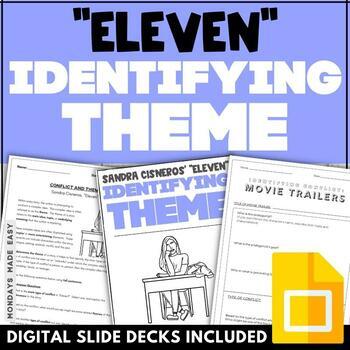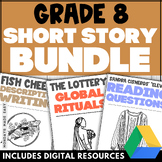Eleven by Sandra Cisneros - Lesson on Theme and Four Types of Conflict - Digital
- Zip
- Google Apps™

What educators are saying
Also included in
- This short story bundle features literary analysis worksheets and activities for classic short stories that students love! Enhance your narrative reading unit with these anchor charts, graphic organizers, pre-reading activities, comprehension questions, vocabulary worksheets, and assessments! SuitaPrice $90.00Original Price $171.85Save $81.85
- This short story unit for Sandra Cisneros’ "Eleven" includes comprehension questions, literary analysis activities, assessment tools, close reading quotations, and informational handouts. Suitable for online learning and Google Classroom®!⚡️⚡️⚡️ Save over 25% with the bundled discount! ⚡️⚡️⚡️Included witPrice $11.00Original Price $15.45Save $4.45
- Explore dystopia, analyze literary conflict, and teach descriptive writing with this short story bundle for Grade 8 English! Includes units for Shirley Jackson’s “The Lottery,” Sandra Cisneros’ “Eleven,” and Amy Tan’s “Fish Cheeks.” Suitable for online learning with digital worksheets for Google ClPrice $25.00Original Price $43.10Save $18.10
Description
Teach students to uncover themes in Sandra Cisneros’ short story “Eleven.” This lesson plan uses popular culture to help students differentiate between the four types of literary conflict in order to identify themes in literature. Suitable for online learning and Google Classroom®!
Included with this Lesson on Theme for “Eleven” by Sandra Cisneros:
✏️ Types of Conflict Worksheet - Digital & Print
✏️ Identifying Conflict in Movie Trailers Activity - Digital & Print
✏️ Conflict and Theme Worksheet for Sandra Cisneros’ “Eleven” - Digital & Print
✏️ Answer Keys
✏️ Teacher Instructions for using this resource
How to use this Theme and Conflict Lesson for “Eleven” by Sandra Cisneros:
Sandra Cisneros’ “Eleven” is a coming-of-age story about a young student named Rachel. On her 11th birthday, Rachel faces a conflict with her grade school teacher, Mrs. Price, uncovering themes of authority, identity, and obedience. Explore the child-like perspective of this classic short story with this lesson plan!
You can begin this lesson by differentiating between types of conflict using the Types of Conflict worksheet. This worksheet defines four types of literary conflict and prompts students to find relevant examples from popular culture for each type:
- Person vs. Person
- Person vs. Self
- Person vs. Society
- Person vs. Nature
Students can then use the Identifying Conflict in Movie Trailers Activity to apply their knowledge about types of conflict. You can select a movie trailer for the entire class to watch, or allow them to select a movie trailer of their preference. For consolidation, an answer key for Netflix’s The Half of It has been included.
Once students have demonstrated their understanding of the different types of literary conflict, they can apply this knowledge to Sandra Cisneros’ short story, “Eleven.” You can use the Conflict and Theme Worksheet for Sandra Cisneros’ “Eleven” to define the term theme and scaffold the process of uncovering themes using literary conflict. This worksheet includes short-answer questions, along with a long-answer question to have students analyze theme in paragraph form.
Students are asked to use evidence from the text to support their long-answer responses. To teach students how to properly cite textual evidence, you can use Mondays Made Easy’s In-Text Citation Worksheets and Activities.
To consolidate this activity, an answer key has been provided. While answers may vary, this answer key includes example answers that can be used to model proper responses for your students.
⭒ For classrooms utilizing Google Classroom® ⭒
To access the digital version of these worksheets, simply follow the instructions within the resource to copy the files directly to your Google Drive®.
✨ Kindly note that due to copyright restrictions, this resource is not editable. This is a common practice within the TPT marketplace in order to protect the clip artists and software providers that have authorized their intellectual property for the development of this resource.
This resource is included in Mondays Made Easy's Literary Analysis Unit for "Eleven" by Sandra Cisneros. This unit includes guided reading questions, literary analysis activities, and a differentiated written response assessment with rubrics. To preview this bundle, click here.
You might also be interested in Mondays Made Easy's Literary Analysis Resources.
➖➖➖➖➖➖➖➖➖➖➖➖➖➖➖➖➖➖➖➖➖➖➖➖➖➖➖➖➖➖➖➖➖➖➖➖➖
⭐ Customer Tip! ⭐
Want FREE CREDIT to go towards purchases? Make sure to offer feedback for your downloads! Follow these instructions below:
- Go to your "My Purchases" page to find a "Provide Feedback" button next to each download.
- Follow this link to offer a quick rating and leave a short comment for the product. Each time you give feedback, TPT gives you feedback credits that you use to lower the cost of your future purchases!
- Your feedback is important to me as it helps me to continually improve my products and ensure they are meeting your needs!
Follow me! Be the first to know about product launches, sales, discounts, and free giveaways:
➾ The Blog
For questions, collaborations, or other concerns:
✉ Contact me: hello@mondaysmadeeasy.com
Access my Free Resource Library!
➖➖➖➖➖➖➖➖➖➖➖➖➖➖➖➖➖➖➖➖➖➖➖➖➖➖➖➖➖➖➖➖➖➖➖➖➖
Mondays Made Easy is committed to the continual improvement of resources to meet the current needs of teachers. This product was last updated on August 31, 2022.








